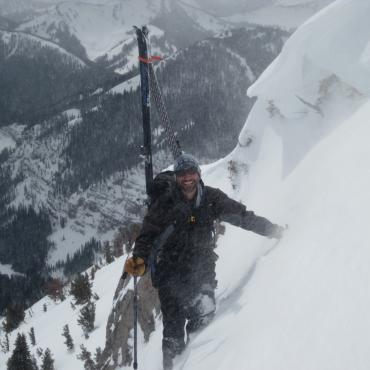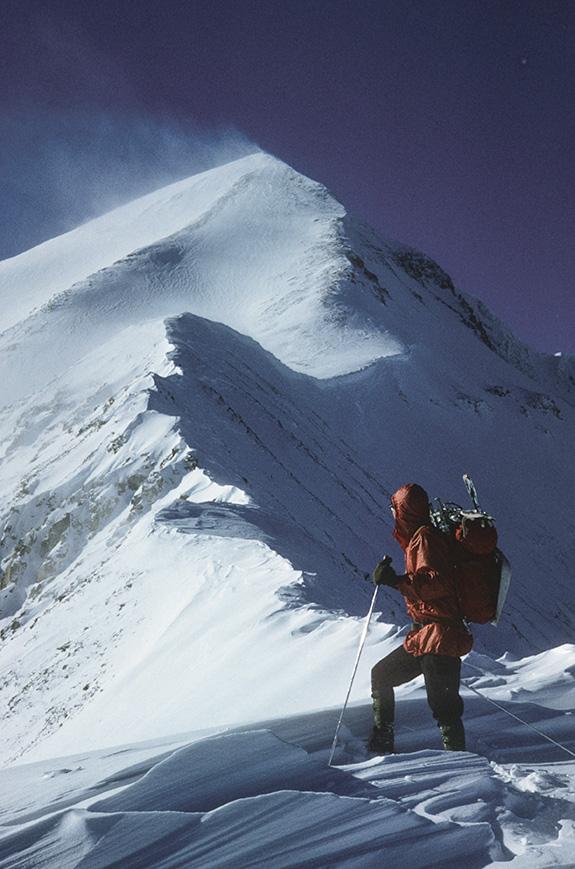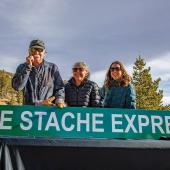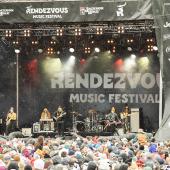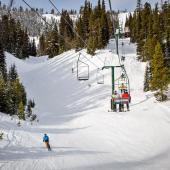Lonely at the Top
These days, Lone Mountain is a ski-world icon. But before they built a tram to the top, you had to earn your turns.
Few other mountains, even the great Cascade volcanoes, exhibit as perfect a cone shape as Lone Mountain. Whereas the volcanoes have truncated summits and craters, Lone Mountain has a relatively pointed summit atop its steep cone. The upper 1,000 feet of Lone Mountain are particularly conical, while the lower few-thousand feet spread out into four distinct ridges, much like the Cascade volcanoes.
Ironically, while Lone Mountain’s current shape actually has little to do with volcanism and much to do with glacier and stream erosion, the mountain’s dacite porphyry composition is evidence of a dramatic volcanic history. About 70 million years ago, today’s Lone Mountain was near the center of a powerful magma intrusion, which may have erupted continually to form one of Greater Yellowstone’s first volcanoes or volcanic vents.
Much like the Cascade volcanoes, Lone Mountain’s primary ridges isolate three main aspects, each with its own character. Between the southeast and southwest ridges is the two-mile-wide south face, which is steep, smooth in appearance, and visible from many points south. The south face contains several outstanding ski features that drop some 2,000 feet from the summit.
In the winter of 1948, Bozeman mountaineering legend Dave Wessel parked along Hwy. 191 in Gallatin Canyon and skied alone with his army-surplus skis, cable bindings, and sealskins to a camp at the base of the southeast ridge. The following day, he skinned and booted to the summit to ski the south face via Liberty Bowl and make the first ski descent of the mountain.
Reminiscent of the large adjacent cirques on the Cascade volcanoes, the north half of Lone Mountain is gouged by four spectacular once-glaciated basins that culminate in steep and craggy headwalls. Separating the basins are four aesthetic ridges, which provide safe climbing routes as well as superb ski terrain. The westernmost cirque, Lost Lake cirque, rises out of a small tarn and is capped by a 2,000-foot, often wind-scoured alpine wall. The next cirque east is known as “Wasteland,” which lies due north of the summit. In the early 1980s, Doug Coombs and Emil Tanner skied north from the summit for 2,000 feet down the North Summit Snowfield into a steep couloir at the center of Wasteland before traversing to Big Sky Mountain Village.
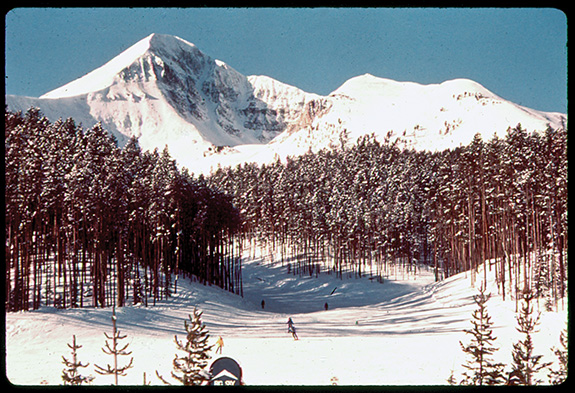
Next to the east is Nashville Basin, which culminates along the northeast ridge well below the summit. A treasure-trove of steep glisse terrain, it contains about a dozen challenging 1,200-foot ski runs that comprise the Gracelands area and Elvis Chutes, now known as the Headwaters.
Lone Mountain’s most impressive aspect is the basin known as “Lone Peak Cirque,” which drains the northeast side of the mountain. Although it would later become a focal point of chute skiing, climbers were the first to seek routes through the cirque’s 1,200-foot near-vertical beds of sandstone, limestone, and shale. On December 12, 1969, Jerry Kanzler, Ray Martin, Clare Pogreba, Peter Lev, and Pat Callis reported a “gratifying ascent” of the face’s main curving snow gully, which today is known as the Big Couloir.
The team drove to the top of nearby Andesite Mountain on a logging road and camped in an abandoned lookout tower. In the morning, Lev and Callis skied to the base of the route, while the others snowshoed. At the couloir’s right-hand curve, the team attempted to complete their climb directly to the summit, but poor rock forced them back into the couloir to finish the ascent. Tragically, only a few weeks after their ascent, Kanzler, Martin, and Pogreba, along with James Anderson and Mark Levitan, died in an avalanche on the west face of Mount Cleveland in Glacier National Park.
Concurrent to the 1969 ascent of the Big Couloir, rumors spread throughout Gallatin Valley of plans for a destination ski resort on Lone Mountain. During the 1960s, significant timber harvests had taken place on “checkerboard” land sections alternately owned by the National Forest and the Burlington Northern Railroad Company adjacent to Lone Mountain in Jack Creek and the Gallatin’s west fork. A subsequent series of land exchanges with the Forest Service gradually consolidated portions of the “checkerboard” near Lone Mountain under the control of Burlington Northern. In early 1970, Burlington Northern announced the sale of much of this land to Chrysler Realty, which formed the Big Sky Corporation with visionary ex-NBC newscaster Chet Huntley as chairman.
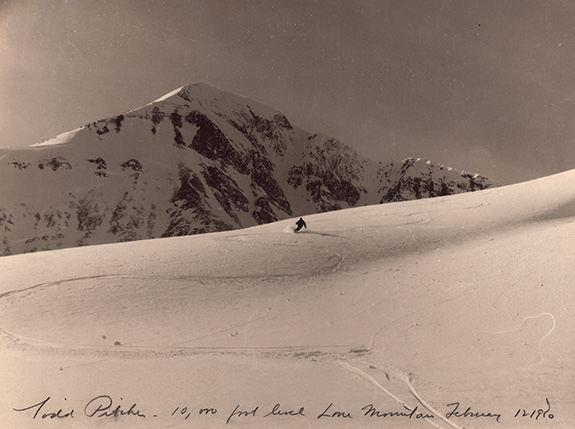
An active period of public discussion ensued on how the resort should be developed, if at all. With exemplary methods, Montana State University coordinated an extensive multi-discipline analysis of the resort’s potential impacts. One of the most contentious issues was how the resort would affect the historic migration of elk between the southern and northern Madison Range. This was mitigated with the precondition that no public road be built across the range connecting Jack Creek with the West Fork Gallatin. Potential construction impacts on the mountain itself were alleviated by digging foundation holes by hand and placing lift towers by helicopter, a rare and expensive occurrence in 1973.
Management also forbade the disturbance of a rock glacier in Lone Peak Cirque. When a bulldozer was used to “walk” a bullwheel up the mountain, a ground crew was assigned to hike the track scar and flip every rock so that its lichen side was facing up. Another item of discussion was how to best preserve a buffer between development at Big Sky and the Spanish Peaks Wilderness to the north. This was mitigated by good-faith plans to keep the area north of the Big Sky road free from development. Eventually, these plans would erode under the pressure of unforeseen growth. Water and sewer systems, built in the 1970s with state-of-the-art technology and exceeding regulatory requirements, were also eventually overwhelmed by patron volume. Water quality problems ensued and remain an issue today.
Nevertheless, Huntley garnered corporate sponsors and began construction of two base villages and a golf course, all in time to open for the 1973-74 ski season. Huntley died the year that the ski area opened and the corporation soon collapsed. In 1976, his partners sold the resort at a substantial loss to Everett Kircher’s Boyne USA Resorts, which used its financial stamina and marketing power to build a famous destination resort by the 1990s. Seventeen lifts were erected on the mountain and numerous multi-million-dollar hotels and housing developments were constructed throughout the West Fork meadows, including areas once set aside as wilderness buffers. Additional land exchanges consolidated more “checkerboard” sections, and gave Big Sky the summit of Lone Mountain, which paved the way for the installation of an aerial tram to the very summit in 1995.
Nevertheless, Lone Mountain has retained its striking beauty and stature throughout three decades of tumultuous politicking and development. Indeed, Lone Mountain not only is the most spectacular commercial ski mountain in America, it is also among America’s premier lift-accessed glisse mountaineering centers. In the Lone Peak Cirque alone, at least five distinct routes and many variations have been skied or snowboarded.
However, these routes have only been lift-served since the tram was installed in 1995. The pioneers of steep skiing on Lone Mountain had to do it the old fashioned way—they first had to climb to the lonely summit. Before tram access, skiers would sign a release and hike to the summit along a spur ridge from the top of the Lone Peak chairlift to access runs on the south face and in Lone Peak Cirque. Only in recent years have the steep routes in Lone Peak Cirque been repeated with any frequency, but skiers are still required to sign out with the ski patrol. Ski routes on the unseen north and west sides of the mountain were even more obscure, known only by the area’s most ardent adventurers.
The southernmost major couloir (other than the Gullies) in the Lone Peak Cirque or northeast face is the Hidden Couloir. This extremely steep and narrow chimney drops through a dogleg from the brink of a hanging snowfield midway on the wall. Above the entry to the Hidden Couloir is the upper northeast face of Lone Mountain, a terrifyingly steep snowfield that ends abruptly at a large cliff band that cuts diagonally across the wall.
During a spell of frigid weather that closed the ski area in 1988, Tom Jungst and Scot Schmidt attempted a direct ascent of the face from the bend in the Big Couloir, as attempted by Lev and Callis in 1969. Unconsolidated snow turned Jungst and Schmidt back into the Big Couloir, which they then ascended to the summit. Although chagrined at not being able to preview the upper face, they started down anyway to the north of where the tramline is today and came within fifty feet of their high point during their ascent earlier in the day. About the connecting chute, Jungst wrote, “The snow was really firm, tight as a drum, and scary.” Wisely, they hiked back to the summit, skied the upper half of the Big Couloir, and finished by traversing into Little Couloir on a hanging ramp.
It was not until the mid-1990s that snowboarder Jason Shutz made the first complete glisse descent of Lone’s direct northeast face—in perfect style. Shutz followed the tramline then veered skier’s right over a cliff band and ridgelet onto the second hanging snowfield. A second jump led him to an exposed ramp that leads into the Big Couloir, which he schussed to the bottom in under one minute from the summit! The route is now referred to as Shutz’s.
Steep ski mountaineering on Lone Mountain was born on June 23, 1973 when Mark Kalitowski solo-skied the mountain’s most classic line, the Big Couloir. Kalitowski worked at Big Sky from 1972 until 1981 and was on the ski patrol there from 1976 to 1981. He described his adventure as follows:
I drove up to where the bottom of the Lone Peak chair is now and camped the night before, then started hiking before sunrise. The snow in the couloir was terrible, all peppered with loose rock, and there was a four-foot-deep water rill down the right side. I fell once and tumbled about a hundred feet, lost a ski pole that stopped another hundred feet below me in that rill. I was just able lay on my belly and touch it with my other pole, but only managed to knock it another hundred feet down the hill. I finally retrieved it and considered abandoning the whole thing, but decided I had put too much into it at that point to quit. I think I topped out at about 10:00, left my equipment at the top of the chute and hiked up to the summit. The upper portion of the couloir had decent snow, though getting pretty wet from the sun. Farther down, it was back into hard frozen melt-freeze with lots of rocks. It was one turn at a time to a complete stop, the rest of the way. Once out of the couloir, it was great corn snow all the way to my car.
Kalitowski repeated his descent of the Big Couloir in the dark a couple of years later with Brian Leo on New Year’s Eve. In a 70-mile-per-hour ground blizzard and minus-20-degree temperatures, they staggered up the southeast ridge to the summit and side-slipped on all fours down the north ridge to the top of the couloir. Dense snow and darkness in the couloir forced the pair to stomp out a platform for each turn. After a physically exhausting descent, they skidded into Big Sky Mountain Village at 11:30pm.
A few years later, in March 1975, Kalitowski pioneered the Little Couloir with Dougal McCarty via an indirect, albeit extremely exposed, entry from the north known as “the Apple Core.” In the spring of 1980 or 1981, Kalitowski and Jon Ueland made the first descent of the direct entry into the Little Couloir, which is sustained at 60 degrees near the top with shallow snow over rocks. Kalitowski had scouted the route for a few years in an attempt to understand the conditions. Even so, when he went first into the couloir, he pushed most of the snow off the rocks at the top and Ueland was forced to pick his way through, nicking his edges in the process.
Jungst recalled one of several attempts to ski the direct Little Couloir in the early 1980s when, just 30 feet from the top, he punched his hand through the thin snowpack into two feet of air over rock. Uncertain as to what was attaching the slab of snow to the rocks, he put on his skis and made haste for the bottom. Farthest to the right on Lone Mountain’s northeast face is a large cliff known as the West Wall, climbed directly to its apex at its highest dimension by Jim Kanzler and Terry Kennedy during the late 1970s or early 1980s. Kanzler described their climb as “a wild alpine route… steep and hard but relatively short.” It reaches the north ridge of Lone Mountain near the top of the Apple Core Couloir.
At the suggestion of snow-safety officer Bruce Tremper, Big Sky installed a rope tow that extended almost to the summit ridge along the spur east of Hidden Couloir during the summer of 1983. Every morning for 13 seasons, ski patrollers would clip a haul rope into their harness and the tow would pull them rapidly about 800 vertical feet up toward the summit ridge. The tow ended well short of safety on the summit ridge and just below an area where hazardous pockets of snow are common. On certain mornings, patrollers would pull an explosive up and over the starting zone on a fixed wire, then anchor their skis and climb the tower at the top station of the rope tow. If the explosion set off a large avalanche, the patrollers would watch the sliding snow rush under their feet as they clung to the lift tower. It was then much safer for them to climb the remaining 75 feet to where they could begin the Alto Traverse to the summit ridge. Bruce Tremper made many changes to the resort’s snow-safety program, which was plagued with misfortune and internal discord before he took it over. With the rope tow, ski patrolmen could more easily access avalanche starting-zones, such as the hanging snowfield above Hidden Couloir, and use the 75mm cannon less often. Before the installation of the Lone Peak tram, local skiers on their way to the summit established a boot track along the line of this rope tow. Like the ski patrol, they would then make an ascending traverse to the upper southeast ridge on their way to the summit.
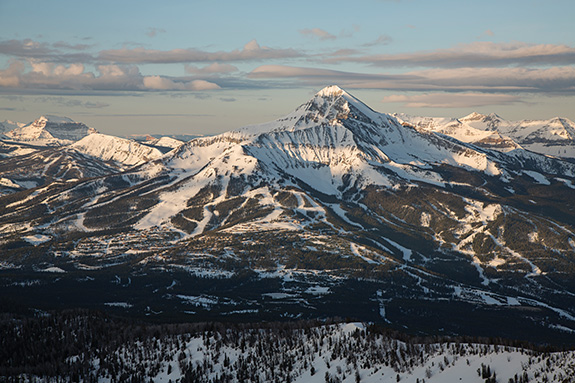
Today, an ascent or descent of Lone Mountain is no longer a wilderness experience, but it can be every bit as invigorating as it was for ski pioneer Dave Wessel, or the forest rangers who packed to the fire-lookout tower on the summit each summer of the early 1900s.
This is an excerpt from Thomas Turiano’s Select Peaks of Greater Yellowstone.

